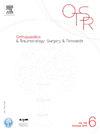Dedicated locking plate reduces non-union risk in open ankle fusion in obese patients
IF 2.3
3区 医学
Q2 ORTHOPEDICS
引用次数: 0
Abstract
Introduction
Obesity is a growing public health concern. In ankle osteoarthritis, non-conservative treatment in advanced stages consists in ankle fusion, or else total ankle replacement, for which obesity is a relative contraindication. One of main complications of ankle fusion is non-union. Devascularization, obesity and fixation material are all factors involved in postoperative non-union, and have to be taken into account in surgical strategy for reliable results. The objective of this study was to compare the rate of ankle non-union in obese patients using quadruple screwing or a dedicated locking plate. The hypothesis was that the locking plate limits the risk of non-union in this population.
Methods
All patients were obese (BMI > 30 kg/m2) and presented ankle osteoarthritis with > 10° intra-articular deformity. The approach and joint preparation were performed via an anteromedial approach. Group S was composed of 32 patients, operated on by quadruple screwing; group P comprised 10 patients operated on using a dedicated locking plate. The main endpoint was a significant difference in the rate of non-union between the 2 groups. The secondary endpoint was improvement in pre- and 6-month postoperative AOFAS score.
Results
Group S presented 31% non-union (10/32) and group P 0% (0/10) (p < 0.05). Postoperative AOFAS score was significantly higher in group P: 67.8 ± 10.4 [range, 40–92] vs. 83.1 ± 8.0 [range, 64–92] (p < 0.05).
Conclusion
The dedicated anterior locking plate is a technique of choice for ankle fusion in obese patients with intra-articular deformity > 10°, to limit the risk of non-union.
Level of evidence
IV; retrospective study.
专用锁定钢板可降低肥胖患者开放式踝关节融合术中的非愈合风险。
引言肥胖是一个日益严重的公共健康问题。对于踝关节骨关节炎,晚期的非保守治疗包括踝关节融合术或全踝关节置换术,而肥胖是相对禁忌症。踝关节融合术的主要并发症之一是不愈合。血管脱落、肥胖和固定材料都是导致术后不愈合的因素,因此必须在手术策略中加以考虑,以获得可靠的效果。本研究的目的是比较肥胖患者使用四联螺钉或专用锁定钢板的踝关节不愈合率。研究假设锁定钢板可降低肥胖患者踝关节不愈合的风险:所有患者均为肥胖者(体重指数大于 30kg/m²),患有踝关节骨关节炎,关节内畸形大于 10°。通过前内侧入路进行入路和关节准备。S组有32名患者,采用四联螺钉固定;P组有10名患者,采用专用锁定钢板。主要终点是两组患者的不愈合率存在显著差异。次要终点是术前和术后6个月AOFAS评分的改善情况:结果:S 组的非愈合率为 31%(10/32),P 组为 0%(0/10)(P 结论:专用前路锁定钢板是一种新型的前路锁定钢板:专用前锁定钢板是关节内畸形大于10°的肥胖患者进行踝关节融合术的首选技术,可限制非愈合风险:证据级别:IV;回顾性研究。
本文章由计算机程序翻译,如有差异,请以英文原文为准。
求助全文
约1分钟内获得全文
求助全文
来源期刊
CiteScore
5.10
自引率
26.10%
发文量
329
审稿时长
12.5 weeks
期刊介绍:
Orthopaedics & Traumatology: Surgery & Research (OTSR) publishes original scientific work in English related to all domains of orthopaedics. Original articles, Reviews, Technical notes and Concise follow-up of a former OTSR study are published in English in electronic form only and indexed in the main international databases.

 求助内容:
求助内容: 应助结果提醒方式:
应助结果提醒方式:


